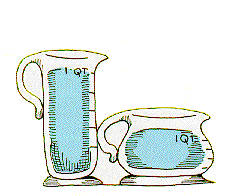STICKY STUFF
Adhesives are used to stick things together. Many adhesives we use every day are made in factories. Others occur in nature and have important uses for plants and animals.
What you'll need
Baking flour
Measuring cup
Egg white
Food coloring
4 small bowls
4 plastic spoons
Aluminum foil
Cotton balls
Toothpicks
Bits of cloth
Glitter
Blunt-tip scissors
Colored yarn or ribbon
Colored paper
Your science journal
What to do
- Search your home to track down everything you can that is sticky. See how many of the following you can find:
Tape
Postage stamps
Car bumper sticker
Envelopes containing glue
Honey
Wall paper with glue
A decal on a t-shirt
Spackle
A bicycle tire patch
Glue for fake fingernails
Peanut butter
An adhesive bandage
- Make a list of everything you can find in nature with an adhesive. For example:
Barnacles that stick to boats, ships, and rocks
Spiders that use sticky threads to create webs that trap their food Pine trees that produce sticky sap
- What adhesives can you think of that are used
in hospitals?
in offices?
in auto repair shops?
- Make a poster or collage using adhesives.
Make 3 bowls of flour-and-water paste. In each bowl, add 1/4 cup water to 1/2 cup flour and mix until smooth. Add a different colored food coloring to each of the 3 bowls and mix.
Crack open an egg and separate the white into a bowl. Throw away the yolk. The white is your clear glue.
Make shapes on your poster or collage out of the colored flour and water paste. Use the egg white to attach aluminum foil, cotton balls, toothpicks, cloth, glitter, ribbon, yarn, and colored paper.
What makes glue, paste, or tape stick to things? Wood, paper, and many other materials have tiny cracks and holes in them. When we glue things together, sometimes the glue seeps into the tiny openings and hardens, making the materials stick together. Other times, the molecules on the surface of an object get tangled up with the glue molecules, making the objects stick together. Finally, glue may stick because of a chemical reaction.
 SPLISH SPLASH
SPLISH SPLASH
There are many ways to measure things. At bath time, use different sized containers to measure volume.
What you'll need
- Measuring spoons and cups of different sizes
- Milk containers of different sizes--for example, pint, quart, half-gallon, and gallon (or 1 liter, 2 liter, and 4 liter)
- A funnel
- 2 containers that hold the same amount (such as a 1 or 2 quart pitcher and storage bowl), but are different shapes--one tall and thin, and one short and squat
Grown-up alert!
- 1 bathtub or sink filled with water
- Your science journal
What to do
- Fill a small container (such as a quart) with water. Then pour the water (using the funnel, if necessary) into a larger container (a half-gallon or gallon). How many small containers does it take to fill one large one?
- How many tablespoons does it take to make half a cup? And how many cups to make a quart?
- Find out how many quarts (or liters) it takes to fill a gallon (or a 4-liter container).
- Next, fill the gallon (or 4-liter) container, and use the funnel to pour the water into the little containers. How many times will it fill the pint (or 1/2-liter) container?
- Fill the short, squat container with a given amount of water--3 cups, for example.
Pour this water into the tall, thin container.
Do your eyes try to tell you the tall, thin container holds more than the short, squat one? Does it hold more?
Can you write all this in your science journal?
Water and other liquids take the shape of whatever container they are in. Containers of certain sizes have names--cup, pint, quart, liter, or gallon, for example. This activity provides an introduction to
volume and
measurement.